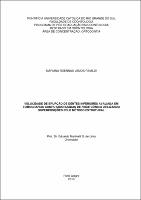| Share record |


|
Please use this identifier to cite or link to this item:
https://tede2.pucrs.br/tede2/handle/tede/1204Full metadata record
| DC Field | Value | Language |
|---|---|---|
| dc.creator | Rinaldi, Mariana Roennau Lemos | - |
| dc.creator.Lattes | http://buscatextual.cnpq.br/buscatextual/visualizacv.do?id=K4447691T4 | por |
| dc.contributor.advisor1 | Lima, Eduardo Martinelli Santayana de | - |
| dc.contributor.advisor1Lattes | http://buscatextual.cnpq.br/buscatextual/visualizacv.do?id=K4792454Z3 | por |
| dc.date.accessioned | 2015-04-14T13:30:21Z | - |
| dc.date.available | 2013-04-29 | - |
| dc.date.issued | 2013-03-06 | - |
| dc.identifier.citation | RINALDI, Mariana Roennau Lemos. Velocidade de erupção de dentes inferiores avaliada em tomografias computadorizadas de feixe cônico utilizando superposições pelo método estrutural. 2013. 287 f. Dissertação (Mestrado em Odontologia) - Pontifícia Universidade Católica do Rio Grande do Sul, Porto Alegre, 2013. | por |
| dc.identifier.uri | http://tede2.pucrs.br/tede2/handle/tede/1204 | - |
| dc.description.resumo | Objetivo: O objetivo deste estudo foi avaliar a erupção dentária dos dentes mandibulares através de tomografias computadorizadas de feixe cônico (TCFC), considerando o estágio de desenvolvimento do germe dentário. O método de superposição estrutural foi utilizado para evidenciar a erupção dentária a partir de uma referência anatômica estável (LRA) e do plano oclusal (PLO). Metodologia: 98 TCFC de 39 indivíduos de 5 a 13 anos foram selecionadas nos arquivos da FO-PUCRS. Foram geradas reconstruções multiplanares semelhantes a radiografias teleperfil com o software Invivo 5.0, salvas em JPEG e superpostas com o software Adobe Illustrator CS3, utilizando-se as estruturas anatômicas estáveis de Björk e Skieller como registro. Os caninos permanentes inferiores, primeiros pré-molares inferiores, segundos pré-molares inferiores e segundos molares permanentes inferiores foram classificados pelo método de Demirjian quanto ao seu estágio de desenvolvimento. Foram obtidas as distâncias destes dentes até LRA e PLO. Para comparar a velocidade dos estágios entre os diferentes dentes foi realizado o teste não-paramétrico de Kruskal-Wallis. As comparações entre a velocidade de erupção (em mm/ano) a partir da LRA com as velocidades a partir do PLO foram realizadas pelo teste de Wilcoxon para medidas relacionadas. Resultados: As maiores velocidades de erupção a partir de LRA foram encontradas para os caninos (5,75 mm/ano) e segundos pré-molares (4,93 mm/ano) nos estágios E e F, respectivamente. As velocidades de erupção medidas a partir da LRA comparadas com as medidas a partir do PLO apresentaram diferenças estatisticamente significativas nos estágios E para os primeiros pré-molares, segundos pré-molares e segundos molares; e no estágio F para os caninos, segundos pré-molares e segundos molares. Conclusão: A velocidade de erupção tende a ser maior quando medida a partir de LRA. Quando se utiliza o PLO, alterações na inclinação do plano e o crescimento alveolar mascaram a velocidade com que o dente é movido de sua posição inicial. | por |
| dc.description.abstract | Introduction: The aim of this study was to evaluate the eruption of the mandibular teeth with Cone-Beam Computed Tomography (CBCT), considering the developmental stage of these teeth. The structural method of superimposition was used to show the dental eruption from a stable anatomical reference line (ARL) and from the oclusal plane (OCP). Method: 98 CBCT of 39 individuals of 5 to 13-years were selected from the archives of the Faculty of Dentistry of PUCRS. Multiplanar reconstructions similar to cephalometric radiographs were generated by Invivo Dental 5.0 software, and saved in JPEG files. The images of each subject were superposed using the software Adobe Illustrator CS3, employing for registration the stables anatomical reference structures from Björk and Skieller. The permanent lower canines, first lower premolars, second lower premolars and permanent lower second molars were classified by development stage with Demirjian method. The distances from these teeth to ARL and OCP were obtained. To compare the speed of the stages among the different teeth was performed the non-parametric test of Kruskal-Wallis. The comparisons between the speeds of eruption (in mm/year) from ARL with OCP were made with Wilcoxon signed-rank test for related samples. Result: The greatest speeds of eruption from ARL were found for canines (5.75 mm/year) and second premolars (4.93 mm/years) in stages E and F, respectively. The speeds of eruption measured from ARL compared with the measured from OCP presented statistically significant differences in the stage E for first premolars, second premolars and second molars; and in stage F for canines, second premolars and second molars. Conclusion: The speeds of eruption tend to be higher when measured from the LRA. When the PLO was used, changes in the inclination of the plan and alveolar growth mask the speed at which the tooth is moved from its initial position. | eng |
| dc.description.provenance | Made available in DSpace on 2015-04-14T13:30:21Z (GMT). No. of bitstreams: 1 447505.pdf: 5416220 bytes, checksum: 73a70704f5124b3fbe94c55da4959744 (MD5) Previous issue date: 2013-03-06 | eng |
| dc.format | application/pdf | por |
| dc.thumbnail.url | http://tede2.pucrs.br:80/tede2/retrieve/8267/447505.pdf.jpg | * |
| dc.language | por | por |
| dc.publisher | Pontifícia Universidade Católica do Rio Grande do Sul | por |
| dc.publisher.department | Faculdade de Odontologia | por |
| dc.publisher.country | BR | por |
| dc.publisher.initials | PUCRS | por |
| dc.publisher.program | Programa de Pós-Graduação em Odontologia | por |
| dc.rights | Acesso Aberto | por |
| dc.subject | ODONTOLOGIA | por |
| dc.subject | TOMOGRAFIA COMPUTADORIZADA | por |
| dc.subject | ERUPÇÃO DENTÁRIA | por |
| dc.subject | ORTODONTIA | por |
| dc.subject.cnpq | CNPQ::CIENCIAS DA SAUDE::ODONTOLOGIA | por |
| dc.title | Velocidade de erupção de dentes inferiores avaliada em tomografias computadorizadas de feixe cônico utilizando superposições pelo método estrutural | por |
| dc.type | Dissertação | por |
| Appears in Collections: | Programa de Pós-Graduação em Odontologia | |
Files in This Item:
| File | Description | Size | Format | |
|---|---|---|---|---|
| 447505.pdf | Texto Completo | 5.29 MB | Adobe PDF |  Download/Open Preview |
Items in DSpace are protected by copyright, with all rights reserved, unless otherwise indicated.




